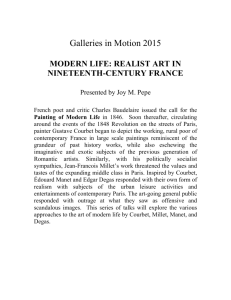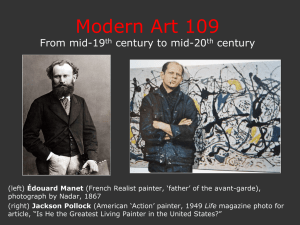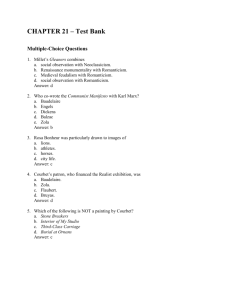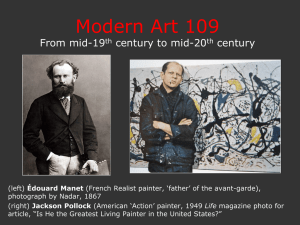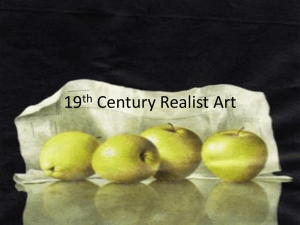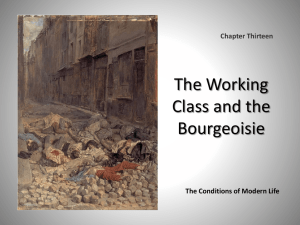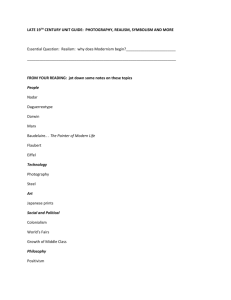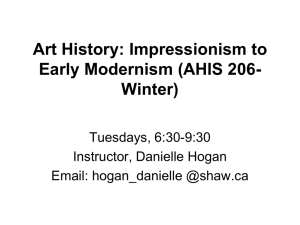Gustave Courbet (1819-1877) Self
advertisement
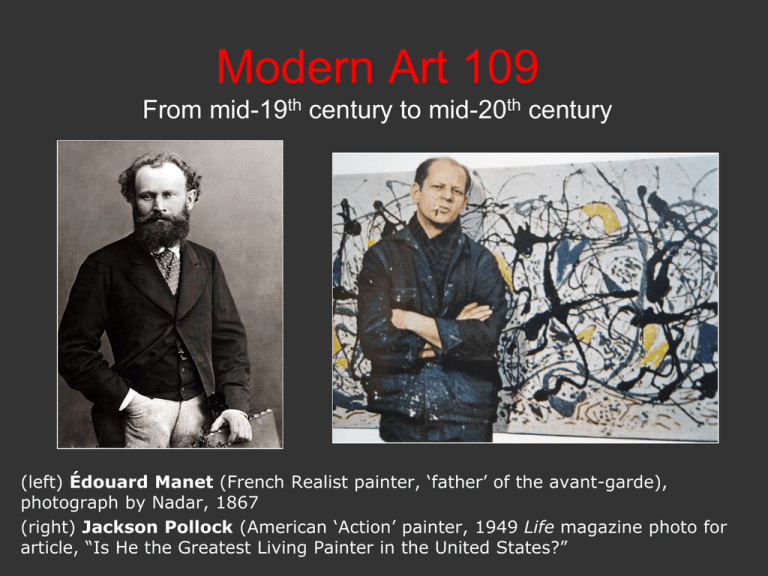
Modern Art 109 From mid-19th century to mid-20th century (left) Édouard Manet (French Realist painter, ‘father’ of the avant-garde), photograph by Nadar, 1867 (right) Jackson Pollock (American ‘Action’ painter, 1949 Life magazine photo for article, “Is He the Greatest Living Painter in the United States?” Realism and the Origin of the Avant-Garde in Paris Gustave Courbet and Edouard Manet Gustave Courbet (French, 1819-1877) Self-Portrait, c. 1845 Gustave Courbet, The Cellist, Self-Portrait, 1847, Oil on canvas 46 1/8 x 35 1/2 in (117 x 90 cm) Nationalmuseum, Stockholm Courbet, Portrait of the Artist (Wounded Man) 1844-54 Oil on canvas 31 7/8 x 38 1/4 in (81 x 7 cm) Musée d'Orsay, Paris Courbet, Man With a Pipe, 1946 Gustave Courbet, Self-Portrait with Dog, 1842 Gustave Courbet, The Stonebreakers, 1849 (destroyed in WW II) "It is not often that one encounters so complete an expression of poverty and so, right then and there I got the idea for a painting. I told them to come to my studio the next morning." Gustave Courbet, Portrait of Proudhon and his Children, 1853 ”Anarchy is Order Without Power” Gustave Courbet, A Burial at Ornans 1849-1850, oil on canvas, 10' 3’ x 21' 9" Musée d'Orsay, Paris. What is ‘avant-garde modern’ about this painting in form and content? Thomas Couture (French Academic painter), Romans of the Decadence, 1847 Gustave Courbet, Burial at Ornans, 1849 compare with Thomas Couture, Romans of the Decadence, 1847 Jean-Baptiste-Siméon Chardin, Grace at Table, 1740 (19"/15") Louvre, Paris Genre painting was a traditional category in European academies of art, which enforced a strict hierarchy of genres that determined a painting’s value: first history, then portrait painting followed by genre, landscape, and still life. Note relatively small size of Chardin’s painting. Courbet’s Burial at Ornans is 10' 3’ x 21' 9" William Bouguereau (left) Mother and Children, The Rest, 1879 (right) Home from the Harvest, 1878, Cummer Museum of Art, Jacksonville, Florida Honoré Daumier (French) , Third Class Carriage, o/c, 1862, c. 25“ x 35" Honoré Daumier, The Uprising, 1849, oil on canvas Gustave Courbet, The Studio: An Allegory of Seven Years of the Artist's Life, 1855, oil on canvas, over 20 feet wide, Musée d'Orsay, Paris “I have studied, outside of any system and without prejudice, the art of the ancients and of the Moderns. I no more wanted to imitate the one than to copy the other; nor, furthermore, was it my intuition to attain the trivial goal of art for art's sake. No! I simply wanted to draw forth from a complete acquaintance with tradition the reasoned and independent consciousness of my own individuality" "To know in order to be able to create, that was my idea. To be in a position to translate the customs, the ideas, the appearance of my epoch, according to my own estimation: to be not only a painter, but a man as well: in short, to create living art - this is my goal.“ Gustave Courbet, statement for his Pavilion of Realism, build next to the Paris International Exhibition of 1855 (left) Destruction of Paris following the Franco-Prussian war, siege of Paris, and (right) the Commune 1871, Communards shot by firing squad of French soldiers in the streets of Paris Courbet, the Communard, and the destruction of the Vendome column, symbol of Napoleonic (French) imperialism "Inasmuch as the Vendôme column is a monument devoid of all artistic value, tending to perpetuate by its expression the ideas of war and conquest of the past imperial dynasty, which are reproved by a republican nation's sentiment, citizen Courbet expresses the wish that the National Defense government will authorise him to disassemble this column.“ – Courbet Gustave Courbet, Self-Portrait at Sainte-Pelagie, 1872 Last self-portrait as prisoner (6 months) for Communard activities. Henri Fantin-Latour. Portrait of Édouard Manet. 1867, oil on canvas Art Institute of Chicago, Chicago Parisian dandy, flaneur, and “Painter of Modern Life” Édouard Manet, At the Café, lithograph, 1869 Édouard Manet, Concert at the Tuileries, 1862 o/c, c. 46 x 30,” National Gallery, London. Two portraits of Charles Baudelaire by Manet on left, 1865 Modernity is the transient, the fleeting, the contingent; it is one half of art, the other being the eternal and the immovable. - Charles Baudelaire Édouard Manet, Le Dejeuner Sur L’Herb (The Luncheon on the Grass), 1862 Titian, Concert Champêtre (Italian Renaissance) 1510 compare with Édouard Manet (French Realism), Le Déjeuner Sur L’Herbe, 1862 Marcantonio Raimondi, Judgment of Paris, (engraving after Raphael), 1520 compare with Édouard Manet, Déjeuner Sur L’Herbe, 1862 Édouard Manet, Olympia, 1863, oil on canvas, 51 x 74¾ in Musée d'Orsay, Paris Titian or Giorgione, Venus of Urbino, 1510 (Louvre) source for Manet’s Olympia 1863 Alexandre Cabanel (French Academic Painter, 1823-1889) The Birth of Venus, 51 x 88 inches, 1863 Jean-Léon Gérôme (French Academic painter), Phrynee Before the Judges, 1861 Honoré Daumier cartoon: “Venuses Again, Always Venuses” William Bouguereau, Birth of Venus, 1879 and Paul Baudry, Venus and Cupid, c. 1857 Édouard Manet, Universal Exposition of 1867, 1867, o/c Painter of Modern Life Emperor Napoleon III by Hipolyte Flandrin (Salon of 1863) with Plan of Paris – radical urban renewal of Paris 1853-1869 designed by Baron Haussmann, 1867 Paris International Exhibition Napoleon III and Baron Haussmann’s urban renewal of Paris:1853-1869 Contemporary view of Blvd. Haussman with Galeries Lafayette, one of the first department stores: commodity culture Édouard Manet, Civil War in Paris (the Commune) 1871, lithograph Édouard Manet, The Bar at the Folies Bergere, 38 x 51 in, 1881, Courtauld, London (left) Gustave Courbet, Portrait of Jo, the Beautiful Irish Girl, c. 1865, oil on canvas, 21 x 26 in. Nationalmuseum, Stockholm, Realism (right) James McNeil Whistler (US), Symphony in White, 1864, Japonisme, aestheticism. Same model, Jo Hiffernan James McNeill Whistler (United States expatriate) Nocturne in Black and Gold: The Falling Rocket, c. 1875, oil on panel, 23 x 18 in, Detroit Institute of Arts “Oh, I knock one off in a couple of days.” (Whistler) Why is a painting made so quickly so highly valued? What are the issues around “art for art’s sake” raised by the Whistler vs. John Ruskin trial? How are they “modern”? Architecture as Emblem of Modernity Modernity is the transitory, the fugitive, the contingent, the half of art, of which the other half is the eternal and the immutable. . . . Charles Baudelaire Top: Joseph Paxton, The Crystal Palace, Hyde Park, London, 1851 Below right: Charles Barry (1795–1860) A. W. N Pugin (1812–52), Houses of Parliament, London, Gothic Revivalism, largely completed by 1858 Contemporaneous English buildings: one emblematic of the future, one emblematic of the past. The House of Lords in the Palace of Westminster (Houses of Parliament), London, designed by A.W.N. Pugin. Neo-Gothic interior design Britain’s Queen Victoria reigned from 1837 to 1901 Her name and values identify the Victorian era in Europe Edwin Landseer (British), Windsor Castle in Modern Times, 1841-5, oil on canvas 44 x 56” Victoria and Albert “at home” Roger Fenton (British, 1819–1869) The Queen and the Prince, wet plate 1854 The Great Exhibition of 1851 in the Crystal Palace by Joseph Paxton architect, Hyde Park, London, England 1851, moved to Sydenham in 1852, burned down in 1936 Queen Victoria opens the Great Exhibition in the Crystal Palace in Hyde Park, London in 1851 Joseph Paxton, Crystal Palace, 1851, detail of exterior structure Building the Crystal Palace with prefabricated truss Building The Crystal Palace from prefabricated iron parts “Waiting for the Queen,” Orientalist décor of Crystal Palace, Illustration by Joseph Nash for Dickinson's Comprehensive Pictures of the Great Exhibition of 1851 Ornamental cover for joints of girders (disguising modernity) Cartoon from Punch, British satirical magazine Crystal Palace Science Exhibit:- Envelope Machine Compare bed and new railroad cars exhibited at Great Exhibition of 1851 (Crystal Palace) William Holman Hunt, The Awakening Conscience, 1853-4 o/c, arched top, 30/22” Tate Britain, Pre-Raphaelite William Morris, La Belle Iseult, 1858, Jane Burden (future Jane Morris) in medieval dress, Pre-Raphaelite. Morris’s only surviving oil painting, Tate, London Red House designed by Philip Webb for William and Jane Morris. Designed 1859; completed 1860. Bexley heath (near London). neo-Gothic eclecticism, meant to be a “palace of art” for artists and writers associated with the Pre-Raphaelite Movement. Inspiration for the Arts & Crafts movement and the assertion of an“authentically” English tradition. The interior surfaces of the Red House were covered with pattern: floors, walls, ceilings. http://www.victorianweb.org/art/architecture/webb/1c.html William Morris, “Pimpernel” wallpaper, 1876. For repeating pattern on wallpaper and fabric, Morris used the ancient technique of hand woodblock printing in preference to roller printing which had replaced it for commercial uses. William Morris, designer, pages from The Kelmscott Chaucer (14th century texts), finished in 1896, figures by Pre-Raphaelite painter, Edward BurneJones Announcing the invention of photography (the daguerreotype) at The Joint Meeting of the Academies of Science and Fine Arts in the Institute of France, Paris, August 19, 1839, unsigned engraving
